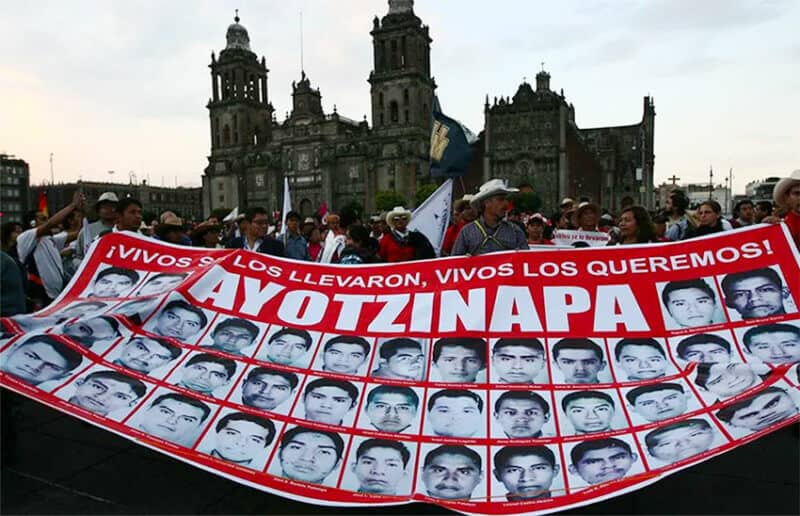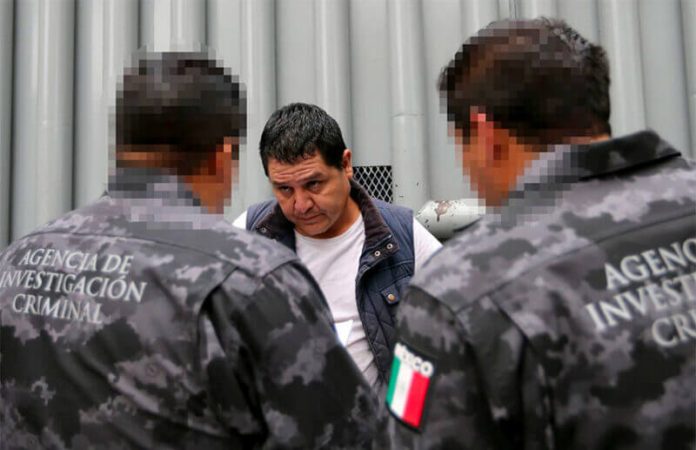At least 38 of 43 students who disappeared in Iguala, Guerrero, seven years ago were handed over to a crime gang by municipal police, intercepted text messages indicate.
The federal Interior Ministry (SEGOB) released a document Friday that includes a transcript of a text conversation between Gildardo López Astudillo, who was allegedly the Guerreros Unidos plaza chief in Iguala at the time of the Ayotzinapa students’ disappearance, and Francisco Salgado Valladares, who was the deputy chief of the Iguala municipal police.
On September 26, 2014 – the day the young men disappeared – the latter tells the former that police have arrested two groups of armed and masked students.
López – identified by his nickname “Gil” in the transcript of the conversation intercepted by the army – tells Salgado to give him some of the students on the road to Pueblo Viejo, a community near Iguala.
He also says he has “some beds to terrorize them,” apparently revealing an intention to torture the students if not kill them.
Salgado tells López he will hand over a group of 21 students being held in a bus so that the Guerreros Unidos can “beat the living daylights out of them.”
The police commander then reveals that a second group of 17 students is being held in a “cave.”
“Give me all the detainees,” responds López. “Send enough people to the Brecha de Lobos [Wolf’s Gap], 17 are going there,” says Salgado.
Later in the conversation, Salgado advises López to tell “Gordo” (Fatty) to stop other students traveling in “more buses.”
He also says that “all the packages were delivered” – an apparent reference to shipments of drugs.
The text conversation supports part of the previous government’s official version of events about what happened to the 43 Ayotzinapa students on September 26, 2014.

According to its so-called “historical truth,” the students, traveling on a bus they commandeered to go to a protest in Mexico City, were intercepted by corrupt municipal police who handed them over to members of the Guerreros Unidos crime gang who subsequently killed them, burned their bodies in a dump in the municipality of Cocula and disposed of their remains in a nearby river.
The federal government has rejected the “historical truth,” but despite launching a new investigation shortly after it took office in late 2018 has not divulged its own definitive version of events.
One theory is that heroin was hidden on the commandeered buses and the students were mistaken for members of a rival gang.
The army has long been suspected of involvement in the abduction and presumed murder of the students, and leaked testimony from a protected witness that was obtained by the newspaper Reforma earlier this year supported that theory.
The federal Attorney General’s office (FGR) has taken statements from at least 30 soldiers since the current government took office but their testimony was heavily redacted in a document recently released by the FGR.
In another text conversation intercepted by the army in October 2014, presumed Guerreros Unidos member Alejandro “El Cholo” Palacios asks a person believed to be a municipal police officer in Tepecoacuilco – which borders Iguala – whether he was aware that all of López’s “graves” had been found.
“Yes, I’m seeing that,” responds the presumed police officer, identified only as Ramón N. in the SEGOB document.
“But don’t you think there is some kind of agreement?” the man asks Palacios, suggesting that López and local authorities might have colluded to hide bodies that were uncovered.
Iñaki Blanco, attorney general of Guerrero at the time of the students’ disappearance, said in a recent interview that the FGR and the Ayotzinapa truth commission should once again conduct a search in Pueblo Viejo and the surrounding area. He also said it’s very likely there are more intercepted text conversations that could shed light on what happened on September 26 and 27, 2014.
“If that is the case they will be useful to establish whether there were links between authorities and members of organized crime or not,” Blanco said.
Meanwhile, parents of the missing 43 – the remains of whom just three have been found – said that authorities’ dissemination of sensitive information about the case is risky because it could compromise the government’s ongoing investigation.
In addition, the parents complained that they neither they nor their lawyers were given access to official documents prior to their release. A committee to which they belong also said the army has withheld real time information it gathered during the abduction of the 43 students.
Not sharing that information violates a presidential decree that obliges the army to tell the Ayotzinapa truth commission what it knows about the case, they parents said.
“These circumstances strengthen our demand for an exhaustive investigation against members of the Mexican army to be opened in order to define their direct or indirect responsibility in the disappearance of our sons,” the committee said.
The parents also called on the federal government to publicly divulge all the information it has about their sons’ disappearance, asserting that drip-feeding the details only exacerbates their pain.
With reports from Milenio
